'Really inspiring': Lily Kahrl struggled to walk; she's now a Wellesley varsity swimmer
WELLESLEY – She jumps into the pool and creates a splash. The act is inaudible. Any noise created from entering the water is drowned out.
She swims a lap that is hardly visible: a wall of supporters along the deck cheers on each stroke and obstructs the view.
Peer behind the curtain of cacophony, look between the flailing arms; the buoyant star’s attraction is revealed: Lily Kahrl’s smile. The glimmering teeth are part of each greeting and farewell, along with a high-five, her signature gesture. Not a limp tap, but one that leaves a red mark – a crackling connection.
Slap!
The girl who did not begin walking until age 3 ½ - an activity a doctor said she’d likely never accomplish – strode past that perceived barrier years ago. The girl who once required assistance from two aides while horseback riding climbed atop a camel during a recent family trip to Kenya. The girl with the rare genetic disorder - STXBP1 encephalopathy; less than 1,000 cases worldwide – is on the Wellesley High girls’ swim team.
The varsity swim team.
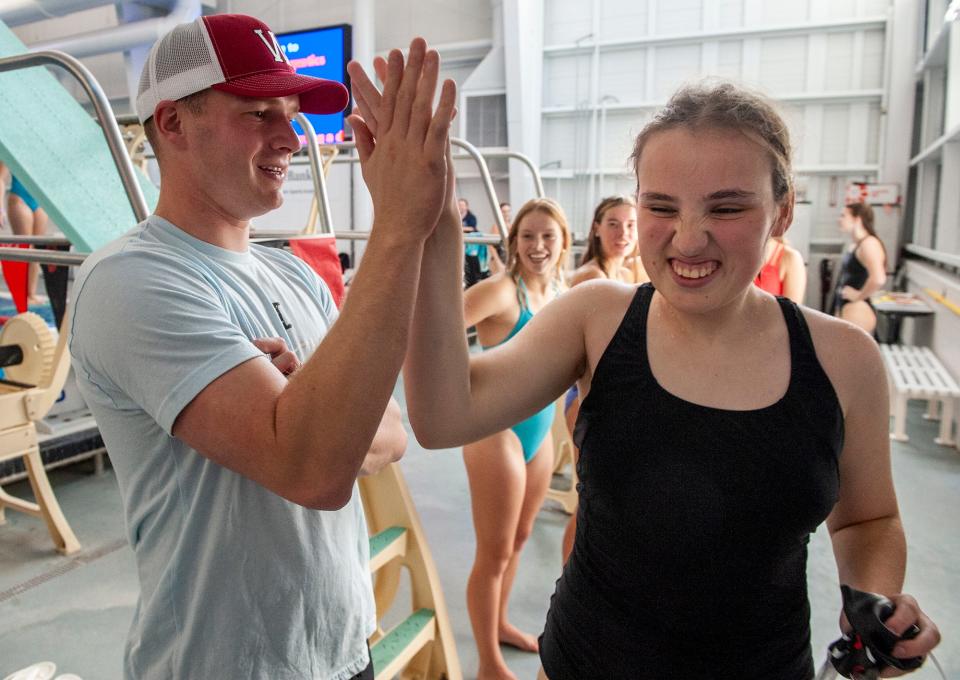
An early-season goal of completing four 50-meter laps during practice has already been surpassed. Lily, surrounded by five of her teammates, beamed her way through 10 of them – up and back on Lane 1 - Wednesday afternoon at Boston Sports Institute.
Asked to describe how it feels to be on the team, Lily, 18, responded bashfully, with her usual brief answer.
“Happy.”
When asked what makes her feel that way, she pointed at her teammates – an expression that led to more smiles, more high-fives.
The best part of being in the water?
“The team.”
Lily is cheered wildly at meets, but does she cheer her teammates on as well?
“Yeah!”
“It’s hard to be negative on the pool deck,” said senior Isabael McKay, “when you watch someone as positive as Lily walk in and be happy every single day to show up and do this work.”
“She’s never sad,” said sophomore Kate Snow. “Even on the days I don’t want to swim, I’ll always swim with her.”
After several attempts, a diagnosis: STXBP1
Lily was diagnosed with STXBP1 encephalopathy - a neurodevelopmental condition that can include epilepsy, varying degrees of cognitive impairment, movement disorders and autism, according to stxbp1disorders.org - six years ago. But her challenges began at birth. When she wasn’t crawling by age 1, her parents – Ben and Karen – refused to listen when a dire prognosis was given for her likelihood of walking.
“One of the doctors said she probably won’t be able to,” Ben Kahrl said, “and we decided that was not something we were going to pay attention to.”
A first diagnosis was vague: global developmental delay. “Which is code for: ‘we know there’s something wrong, but we don’t really know what it is,’” Ben said.
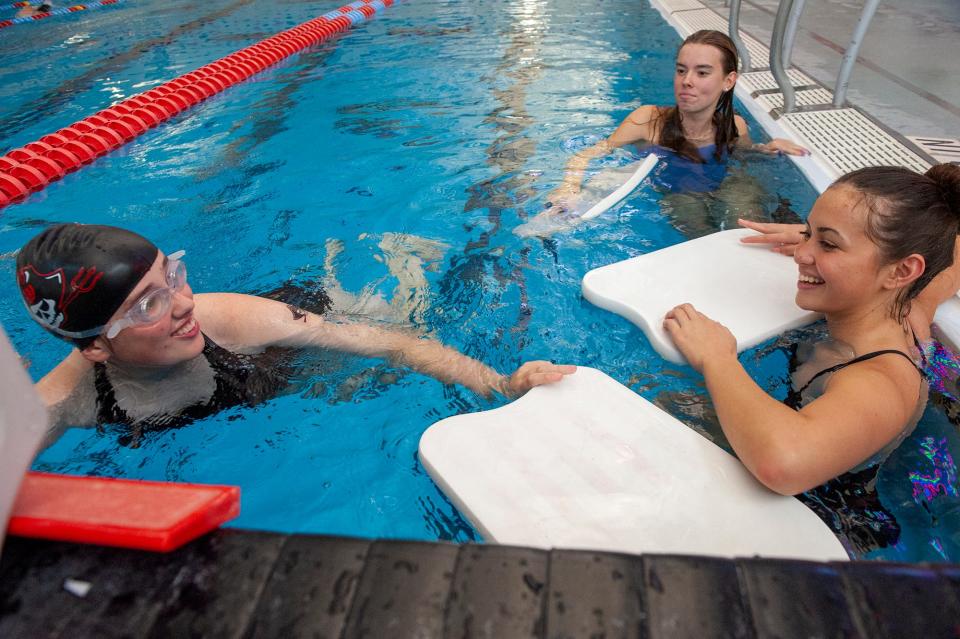
Next: Spinocerebellar ataxia type 13. Then: Ohtahara syndrome.
“One of the things we realized along the way,” Ben said, “whatever the diagnosis was going to be, there was no quote-unquote cure.”
No road map, either. Not for a disorder that was just discovered in 2008. An Oct. 1 tweet by stxbp1disorders.org reported the latest census for STXBP1: just 951 documented cases worldwide, 295 in the US.
The Q3 #STXBP1 Census has been published. 951 STX'ers in 47 countries -- including our first patient in Indonesia
Be counted! https://t.co/nxAFMnmOND@stxbp1 #stxbp1globalconnect pic.twitter.com/wOSIfzkQ9x— stxbp1 (@curestxbp1) October 1, 2023
Lily has for years undergone occupational, physical and speech therapy and attended school at Nashoba Learning Group in Bedford since 2017 after attending Sprague Elementary School in Wellesley through fifth grade. She learned to ride a horse at BINA Farm in Lexington.
At Wellesley High, she, helped by an aide, takes separate math, science and English courses but is integrated with the school population for chorus and art and participates in an adaptive physical education class. Lily is likely to be a part of the school’s musical.
Like a person with Down syndrome or on the autism spectrum, Lily is considered neurodiverse. The chance to attend public school again was too good to pass up, according to Ben Kahrl.
“We thought this might be her only chance to be in a predominantly neurotypical environment,” he said.
Wellesley coach Doug Curtin welcomes Lily onto swim team
When the Kahrl family dipped their toes into another body of uncharted water, Wellesley High girls swimming coach Doug Curtin threw them a lifeline. Inquiring about including his daughter into the program, Ben Kahrl molded his expected reply.
“I emailed him,” Kahrl said, “honestly thinking he’d say: ‘great, but no. It would be too hard.’”
But Curtin had experience – and success – with similar inclusion processes.
A boy on the autism spectrum participated for four years on the Wellesley varsity (Curtin also coaches the Wellesley boys in the winter) and when Curtin was a Wayland High School swimmer a little more than 10 years ago, he mentored a special needs child – Griffin Brown - in that town’s recreation program. Brown later swam on the Wayland High varsity.
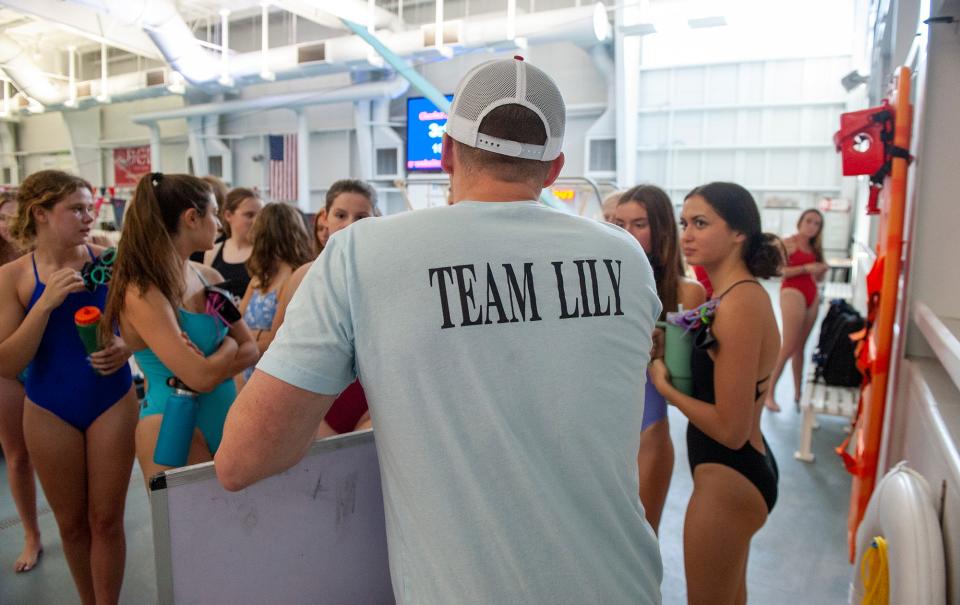
Wellesley’s girls’ program also has a middle schooler with Down syndrome – Paytton Gagnon – who serves in a team manager role, timing races at home meets and cheering on the team.
Curtin’s answer to the Kahrls? Yes – and she can race, too.
“They were unsure about it,” Curtin said. “It’s not a huge lift on our end and that’s the biggest thing that we want to get across, is that being inclusive doesn’t take a monumental approach in the way you approach things.”
Lily, whose older sister Ella is a two-sport athlete at Connecticut College, has participated in programs specifically tailored to special needs individuals: TOPSoccer; Wellesley S.T.A.R.S. (Striving To Achieve Recreational Services); Unified track. But immersing Lily into a neurotypical environment is new. And challenging, which is part of the goal.
“I think if people saw how it was working,” said Wellesley senior Lindsey Youngren, “they could see how beneficial it could be.”
When Lily swims at meets, ‘it’s electric’
Lily practices with the Wellesley High team twice a week. She has her own lane at one end of the pool while most of her teammates swim countless laps in middle lanes. The workouts are routine, even monotonous.
But not for Lily.
“She shows up at every single practice with a huge smile on her face,” said sophomore Brooke Loftus. “It just brings positivity to practice and it makes everyone want to do better because they’re watching her improve so fast. It’s really inspiring.”
Meets bring out even more of Lily’s personality. When the team gathers the night before, they exchange “secret psycher” notes, designed to get the Raiders amped up for the coming competition. Lily makes sure to include everyone’s favorite candy with her words of encouragement.
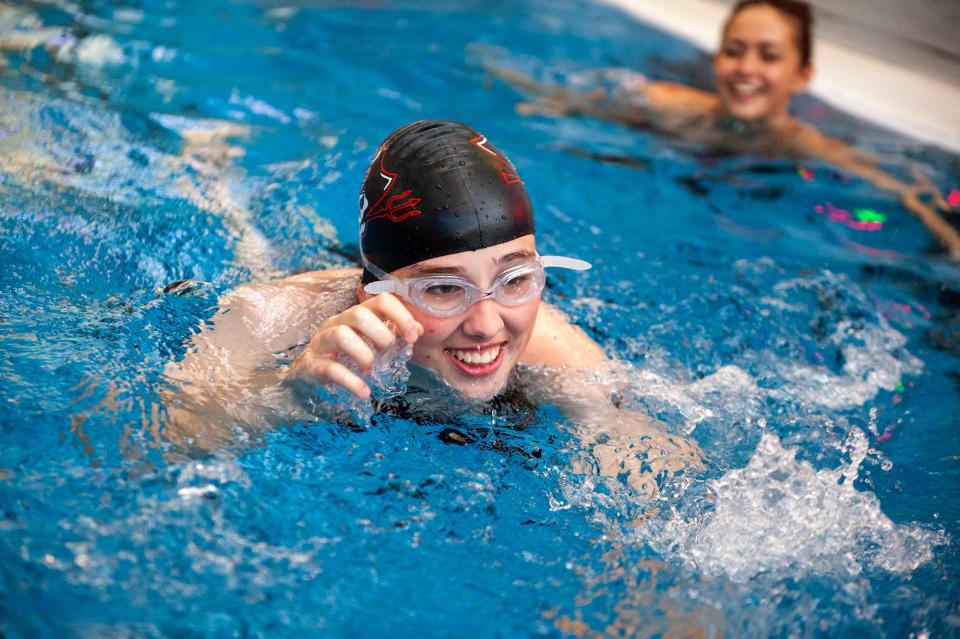
Lily swims the 50 meters on race days and draws an exuberant following. After teammates help put her cap and goggles on, they guide her over to the top of the starting block, which represents another goal reached: Lily previously jumped in from the side of the pool.
When the race begins, a gathering of not just her teammates but members of the opposing team lines the deck and loudly cheers each stroke.
“It’s electric,” said sophomore Evie Murillo. “It’s a great team moment.”
Wellesley’s second meet of the season, against Framingham, may have been the loudest when both squads voiced their approval.
“I was brought to tears, basically, just with how cool it was to see everybody rallying around her,” Curtin said. “When she hits the wall (at the finish) and pops her head out, the place goes nuts every time.”
What’s next for Lily Kahrl? Another unknown
Beyond this school year, Lily’s future is unclear. She could remain at Wellesley High, although that scenario requires a waiver. She could enter the school district’s LAUNCH program, designed to enhance, among other aspects, her development of independent living skills, social development and vocational experience.
But any post-high school educational services end at 22, an age Ben Kahrl referred to as “the cliff."
Not enough is known about STXBP1 to predict what will happen in adulthood. Life expectancy studies have also come back inconclusive. For individuals with Down syndrome or on the autism spectrum, “there’s a little more of a road map,” Ben Kahrl said. “For these kids, there’s no road map. It’s a lot of ‘we don’t know.’
“Is there an independent living situation? Some of the independent living situations for adults are really awful. It’s hard and you don’t know. We’ve got four years, but we’re trying to figure that out.”
This year has gone swimmingly for the Raiders, who own a 71-meet conference win streak that dates back to 2016. Lily’s presence is a win in itself.
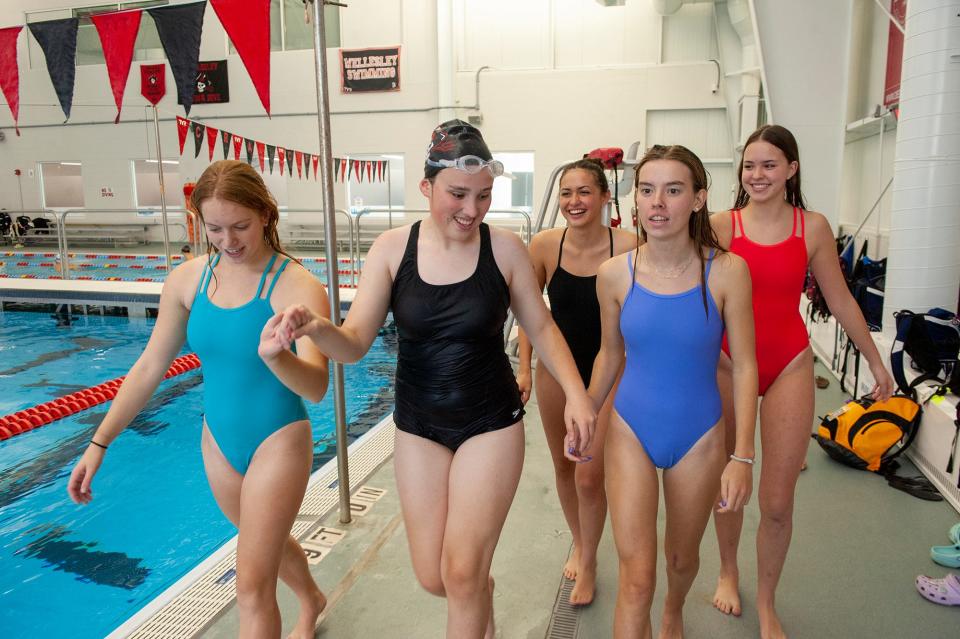
“It’s probably one of the best opportunities I’ve had on this team,” Murillo said. “It’s a great chance for us as a team to incorporate people who don’t have the same opportunities as us.”
The smiles, the high-fives – the jokes with teammates about Lily stealing someone’s dinner – will continue throughout the fall. She is learning how to read, and more breakthroughs (12 laps in the pool?) are likely.
Lily’s life resembles that of any other: day-to-day.
“Part of it is simply saying: the person that she’s quote-unquote competing against is her yesterday self and can her tomorrow self be more capable?” Ben Kahrl said. “What that means in 10 years, we really don’t know.”
Tim Dumas is a multimedia journalist for the Daily News. He can be reached at tdumas@wickedlocal.com. Follow him on Twitter @TimDumas.
This article originally appeared on MetroWest Daily News: Rare developmental disorder hasn't kept Wellesley swimmer from varsity

